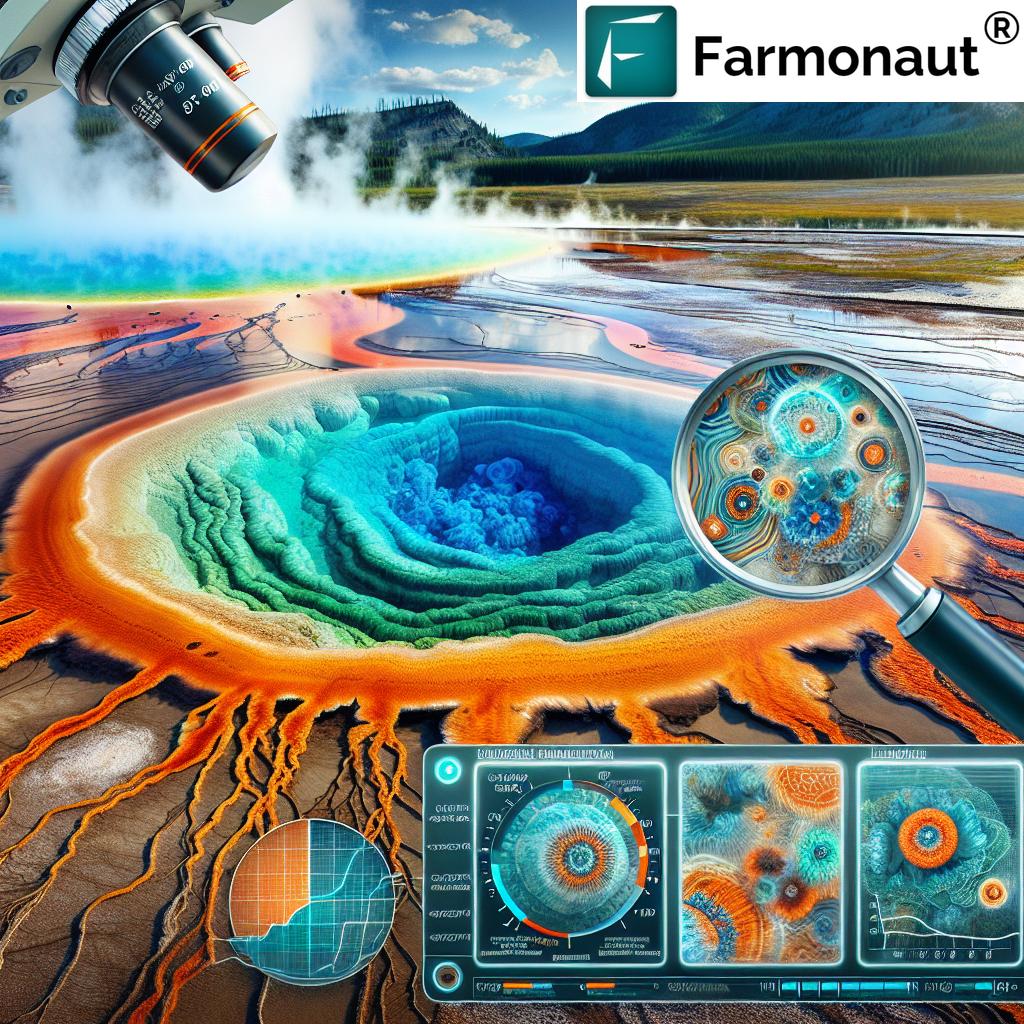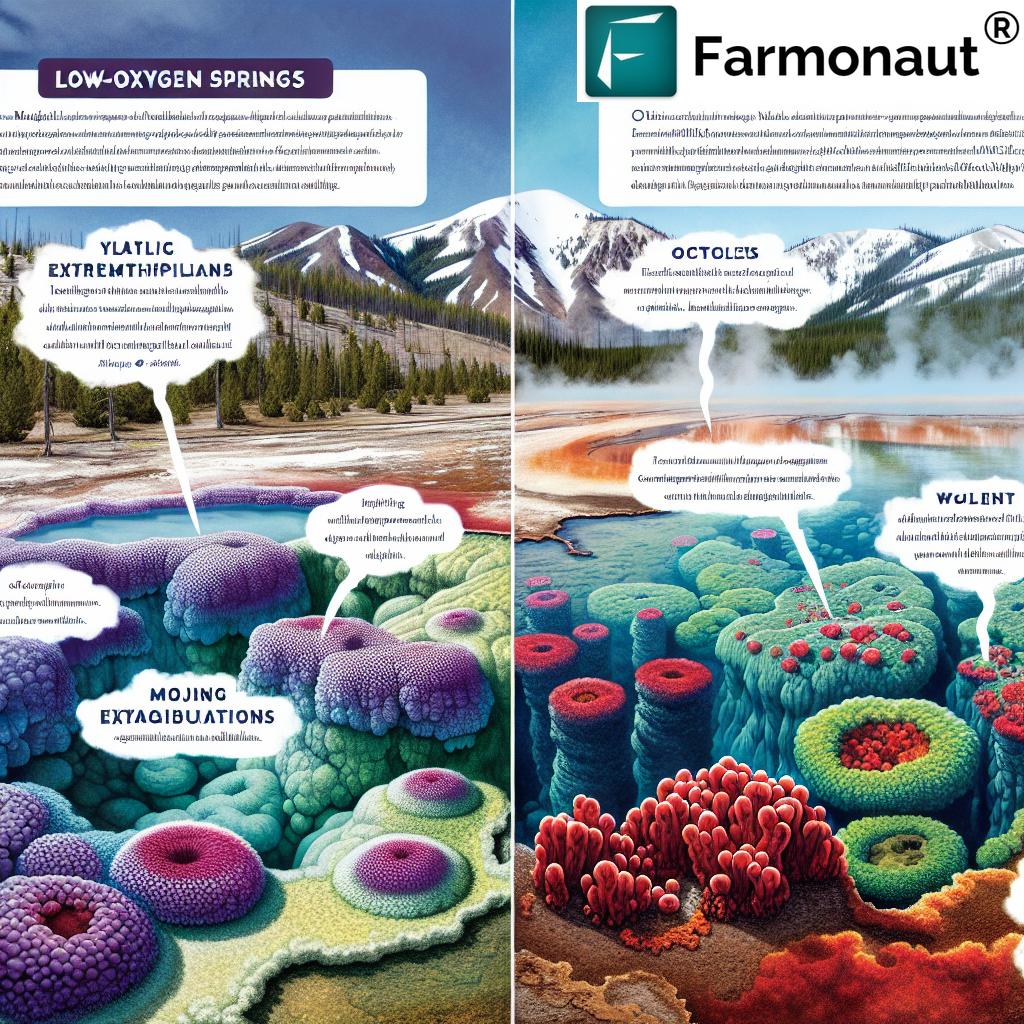Unlocking Earth’s Ancient Secrets: Yellowstone’s Thermophiles Reveal Microbial Adaptation to Oxygen Evolution
“Yellowstone’s thermophiles thrive in hot springs with temperatures exceeding 80°C (176°F), adapting to extreme conditions over billions of years.”
In the realm of scientific discovery, few areas captivate our imagination quite like the exploration of Earth’s ancient secrets. Today, we embark on a fascinating journey into the heart of Yellowstone National Park, where groundbreaking research on microbial adaptation to oxygen is shedding light on the evolution of early life on our planet. As we delve into this captivating subject, we’ll uncover how these tiny, resilient organisms have thrived in extreme conditions for billions of years, offering us invaluable insights into the foundations of life itself.
The Yellowstone Hot Springs: A Window into Earth’s Past
Yellowstone National Park, with its vibrant geothermal features, serves as a natural laboratory for scientists studying the origins of life. The park’s hot springs, characterized by their extreme temperatures and unique chemical compositions, provide an environment that closely resembles the conditions of early Earth. It’s here that researchers from Montana State University (MSU) have made remarkable discoveries about how ancient microorganisms adapted from low-oxygen environments to the oxygen-rich atmosphere we know today.

The study, led by MSU professor Bill Inskeep and associate professor Mensur Dlakic, builds on over two decades of scientific investigations in Yellowstone. Their findings, published in the prestigious journal Nature Communications, offer unprecedented insights into the respiratory processes of hyperthermophiles in sulfidic and low-oxygen thermal springs.
Conch Spring vs. Octopus Spring: A Tale of Two Environments
At the heart of this research lies a comparison between two geochemically similar hot springs in Yellowstone: Conch Spring and Octopus Spring. While both springs share many characteristics, they differ significantly in one crucial aspect: their oxygen levels. Conch Spring exhibits higher levels of sulfide and lower levels of oxygen, whereas Octopus Spring is more oxygen-rich.
This natural variation provides scientists with a unique opportunity to study how microorganisms evolve in response to different oxygen concentrations. By comparing the microbial communities in these two springs, researchers can gain insights into the adaptations that occurred during the Great Oxidation Event, a pivotal moment in Earth’s history that took place approximately 2.4 billion years ago.
The Great Oxidation Event: A Turning Point in Earth’s History
The Great Oxidation Event marked a significant increase in atmospheric oxygen levels, fundamentally altering Earth’s environmental landscape. This dramatic shift in our planet’s chemistry had profound implications for the evolution of life, forcing organisms to adapt or perish in the face of a changing world.
Inskeep and Dlakic’s research aims to understand how early-evolved thermophiles played a role in the transition to oxygen-utilizing organisms. By studying the differences in microbial communities between Conch Spring and Octopus Spring, they’ve uncovered fascinating clues about how life evolved in response to changing oxygen levels.
Thermophilic Microbes: Masters of Adaptation
The presence of three types of thermophilic microbes in both springs offers valuable insights into the evolution of life in extreme environments. These remarkable organisms, thriving in temperatures of approximately 190 degrees Fahrenheit (88°C), form “streamers” that resemble small kelp. They grow by attaching to rocks and extending filamentously into the spring’s currents.
While some species were common to both springs, the diversity of organisms in Octopus Spring was significantly higher, indicating a greater evolutionary adaptation to oxygen. This observation aligns with our understanding of how life forms have diversified and specialized over time in response to environmental pressures.
Respiratory Genes: The Key to Understanding Microbial Adaptation
One of the most significant aspects of this research is the analysis of respiratory genes in the microbes found in both springs. In Conch Spring, genes suited for low-oxygen environments were found to be more active. Conversely, in Octopus Spring, higher oxygen adaptations were predominant. This genetic evidence reflects the evolutionary pressures exerted by their respective environments and provides a clear picture of how these ancient organisms have adapted over time.
“Scientists compared microbial communities in two geochemically similar hot springs, revealing adaptations to oxygen levels differing by up to 30%.”
To better understand these adaptations, let’s take a closer look at the comparative analysis of microbial communities in these two Yellowstone hot springs:
| Characteristics | Conch Spring | Octopus Spring |
|---|---|---|
| Temperature | ~190°F (88°C) | ~190°F (88°C) |
| Oxygen Levels | Low | High |
| Sulfide Content | High | Low |
| Dominant Microbial Species | Low-oxygen adapted thermophiles | Diverse oxygen-tolerant thermophiles |
| Respiratory Processes | Anaerobic respiration dominant | Aerobic respiration prevalent |
| Adaptations to Oxygen | Genes for low-oxygen environments active | Genes for higher oxygen adaptations predominant |
This table clearly illustrates the stark differences between the two hot springs and the microbial communities they support. It’s a testament to the incredible adaptability of life and the diverse strategies that organisms can employ to thrive in different environmental conditions.
Implications for Our Understanding of Life’s Evolution
The study of these ancient microorganisms may seem distant from human life, but it enhances our understanding of life’s evolution and how organisms adapt to their environments. This knowledge is crucial for grasping the foundations of biological diversity on Earth and may even have implications for our search for life on other planets.
As Dlakic emphasizes, studying simple life forms is necessary to comprehend the complexities of advanced life forms. There’s a deep connection between past microbial life and current forms of existence, and understanding this connection can provide valuable insights into our own biology and the challenges we face in a changing world.

The Role of Technology in Modern Environmental Research
While the study of ancient microorganisms relies heavily on field research and laboratory analysis, modern technology plays an increasingly important role in environmental studies. Advanced remote sensing techniques, for example, can provide valuable data on environmental conditions across large areas, complementing the detailed, localized studies conducted in places like Yellowstone.
At Farmonaut, we’re at the forefront of leveraging technology for environmental monitoring and agricultural management. Our satellite-based crop health monitoring system uses multispectral imagery to assess vegetation health, soil moisture levels, and other critical metrics. While our primary focus is on agriculture, the principles behind our technology can be applied to a wide range of environmental studies.
For instance, our satellite and weather API could potentially be used by researchers to gather data on environmental conditions in areas of interest. This kind of remote sensing data, when combined with on-the-ground research, can provide a more comprehensive picture of environmental changes and their impacts on microbial communities.
The Future of Microbial Research and Its Implications
As we continue to unlock Earth’s ancient secrets through the study of thermophiles in Yellowstone and other extreme environments, we’re not just learning about the past – we’re gaining insights that could shape our future. The adaptations these microorganisms have developed over billions of years could inspire new biotechnologies, inform our understanding of climate change impacts, and even guide our search for life on other planets.
Moreover, the research methods and technologies developed for studying these extreme environments have applications far beyond microbiology. They demonstrate the power of interdisciplinary research, combining geology, chemistry, biology, and advanced data analysis to paint a comprehensive picture of life’s evolution.
Connecting Ancient Life to Modern Agriculture
While the study of ancient microbes might seem far removed from modern agriculture, there are fascinating connections to be made. The adaptability and resilience demonstrated by these organisms in extreme environments offer lessons that could be applied to developing more resilient crops in the face of climate change.
At Farmonaut, we’re passionate about leveraging cutting-edge technology to support sustainable agriculture. Our API developer docs provide detailed information on how our satellite and AI-based solutions can be integrated into various agricultural applications. By combining insights from ancient life forms with modern technology, we can work towards creating more resilient and sustainable food systems.
The Role of AI in Understanding Complex Biological Systems
As we delve deeper into the complexities of microbial adaptation and evolution, artificial intelligence (AI) is becoming an increasingly valuable tool. AI can help us analyze vast amounts of data, identify patterns that might be invisible to human researchers, and even predict how organisms might respond to changing environmental conditions.
At Farmonaut, we’re harnessing the power of AI through our Jeevn AI Advisory System. While primarily focused on agricultural applications, the principles behind this system – using AI to analyze environmental data and provide actionable insights – could potentially be applied to microbial research as well.
Conclusion: The Endless Frontier of Microbial Research
As we conclude our exploration of Yellowstone’s thermophiles and their remarkable adaptations to oxygen evolution, we’re left with a sense of awe at the complexity and resilience of life on Earth. From the scalding hot springs of Yellowstone to the most extreme environments on our planet, microorganisms continue to surprise and inspire us with their ability to thrive in conditions we once thought impossible.
The research conducted by scientists like Inskeep and Dlakic not only enhances our understanding of life’s evolution but also opens up new possibilities for biotechnology, environmental management, and even the search for extraterrestrial life. As we continue to unlock Earth’s ancient secrets, we’re not just learning about our past – we’re gaining invaluable insights that could shape our future.
At Farmonaut, we’re excited to be part of this journey of discovery and innovation. While our focus is on revolutionizing agriculture through technology, we recognize the interconnectedness of all life on Earth. The lessons we learn from studying ancient microbes can inform our approach to sustainable farming, resource management, and environmental conservation.
As we look to the future, it’s clear that the study of microbial adaptation will continue to play a crucial role in our understanding of life on Earth and beyond. By combining cutting-edge technology with rigorous scientific research, we can unlock even more of Earth’s ancient secrets and use that knowledge to build a more sustainable and resilient future for all.
FAQ Section
- Q: What are thermophiles?
A: Thermophiles are microorganisms that thrive in extremely hot environments, typically above 45°C (113°F). They are found in hot springs, hydrothermal vents, and other geothermally heated habitats. - Q: Why is studying thermophiles in Yellowstone important?
A: Yellowstone’s hot springs provide a unique environment that resembles conditions on early Earth. Studying thermophiles here helps us understand how life evolved and adapted to changing environmental conditions over billions of years. - Q: What is the Great Oxidation Event?
A: The Great Oxidation Event was a period about 2.4 billion years ago when oxygen levels in Earth’s atmosphere significantly increased. This event had a profound impact on the evolution of life on our planet. - Q: How do thermophiles adapt to different oxygen levels?
A: Thermophiles adapt to different oxygen levels through various mechanisms, including changes in their respiratory genes. Some are adapted to low-oxygen environments, while others have evolved to thrive in more oxygen-rich conditions. - Q: What can we learn from studying ancient microorganisms?
A: Studying ancient microorganisms helps us understand the foundations of life on Earth, how organisms adapt to extreme conditions, and potentially how life might exist on other planets. It also provides insights that could be applied to biotechnology and environmental management.
Earn With Farmonaut: Affiliate Program
Earn 20% recurring commission with Farmonaut’s affiliate program by sharing your promo code and helping farmers save 10%. Onboard 10 Elite farmers monthly to earn a minimum of $148,000 annually—start now and grow your income!
Farmonaut Subscriptions
Experience the power of Farmonaut’s advanced agricultural solutions:







